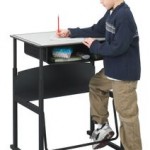 Why is it that we expect children to sit quietly in their seats while they’re being taught in school? We even use the word “seatwork” to describe this behavior. I want to know who made this decision. I can imagine some grizzled old scholar somewhere in Europe during the late eighteenth century thinking: “You know, I really like the look of those kids sitting up straight in those wooden desks! Such great posture! And there’s a wonderful sense of orderliness to it! I think that’s how it should be for every student from here on out!”
Why is it that we expect children to sit quietly in their seats while they’re being taught in school? We even use the word “seatwork” to describe this behavior. I want to know who made this decision. I can imagine some grizzled old scholar somewhere in Europe during the late eighteenth century thinking: “You know, I really like the look of those kids sitting up straight in those wooden desks! Such great posture! And there’s a wonderful sense of orderliness to it! I think that’s how it should be for every student from here on out!”
Well, the latest information we have about how children learn and grow suggests that students may be far better off standing while they work, both from a health perspective and a learning point of view. The American Journal of Public Health reported a study where students in four central Texas classrooms were allowed to stand while they worked. They were provided with desks that were high enough to allow them to work standing up, but they were also given stools to use if they preferred sitting. No other specific instructions were given. After six weeks, 70% of the students never used their stools to sit, and the other 30% stood a majority of the time they worked at their desks.
Students were monitored with calorie-expenditure arm-bands to measure their energy output. Students in the treatment group (those who used the stand-up desks) , showed a significant increase in calorie expenditure over the control group (students who sat in conventional desks). The study has important implications for the growing public health problem of childhood obesity. We’ve already got “couch potato kids.” Do we really need “desk potato kids?”
Another novel intervention that provides a different kind of alternative to the “seatwork” approach to learning, is where students are given brightly colored exercise stability balls to sit on while they study. Students are given specific rules for how the balls are to be used (e.g. no dribbling them in the classroom, no throwing at other students etc.). A study at the Mayo Clinic suggests that student’s posture actually improves, as does their muscle strength, and perhaps most importantly, their concentration on their schoolwork.
Another study revealed that exercise balls were particularly helpful for those wiggly children diagnosed as having attention deficit hyperactivity disorder. This study, which appeared in The American Journal of Occupational Therapy, revealed that the stability ball intervention actually increased levels of attention, decreased levels of hyperactivity, and increased “time-on-task” with respect to schoolwork. Moreover, both students and teachers preferred the exercise balls over the standard desk, or chair and table arrangement. So, parents and teachers, it may be time to let go of the notion that the best classroom is one where all the students are sitting quietly in their seats engaged in their schoolwork. Learning is life, and life is movement!
Photo Source: ATD American
For more information about standing desks and other ergonomic classroom furniture, as well as lots of ideas for helping kids diagnosed with ADHD, see my book The Myth of the ADHD Child, Revised Edition: 101 Ways to Improve Your Child’s Behavior and Attention Span Without Drugs, Labels, or Coercion
This article was brought to you by Thomas Armstrong, Ph.D. and www.institute4learning.com.
Follow me on Twitter: @Dr_Armstrong




















Great message sending, a lot of health issues can be addresed when you use a adjustable-standing desk from your home based work to office. It Improves posture and lessens back pains from school and from work.
Your message was amazingly timed, I usually work standing up, but I’d been working sitting for the last two or three weeks and had to stop because of back pain. So I’m back to standing! Thanks!